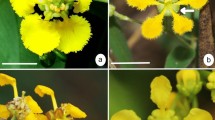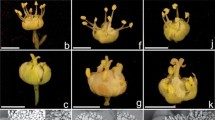Abstract
Mazus japonicus is predominantly self-pollinated,M. miquelii mostly cross-pollinated, with a low degree of self-incompatibility. Correlated differences effect structure, development and seismonasty of the stigma, spatial relationships of stigma and anthers, and pollinator visits.M. japonicus produces numerous and light,M. miquelii fewer and heavier seeds. Growth experiments under different temperature regimes demonstrate thatM. japonicus dies after flowering and fruiting, and behaves as an annual, whileM. miquelii has additional asexual propagation and is clearly perennial.M. japonicus grows in somewhat drier and more disturbed habitats thanM. miquelii.
Similar content being viewed by others
References
Antonovics, J., 1968: Evolution in closely adjacent plant populations. V. Evolution of self-fertility. — Heredity23, 219–238.
Baker, H. G., 1959: Reproductive methods as factors in speciation in flowering plants. — Cold Spring Harbor Symp. Quant. Biol.24, 177–190.
Fryxell, P. A., 1957: Mode of reproduction of higher plants. — Bot. Rev.23, 135–233.
Harper, J. L., 1967: A Darwinian approach to plant ecology. — J. Ecol.55, 247–270.
Harper, J. L., Ogden, J., 1970: The reproductive strategy of higher plants. I. The concept of strategy with special reference toSenecio vulgaris L. — J. Ecol.58, 681–698.
Kawano, S., 1974: Evolutionary Biology in Plants. II. Speciation and Adaptation. — Tokyo: Sanseido (in Japanese).
Lefébvre, C., 1970: Self-fertility in maritime and zinc mine populations ofArmeria maritima (Mill.)Wild. — Evolution24, 571–577.
Miyoshi, M., 1891: Notes on the irritability of the stigma. — J. Coll. Sci. Tokyo4, 205–213.
Newcombe, F. C., 1924: Significance of the behavior of sensitive stigmas. II. — Amer. J. Bot.11, 85–93.
Sakamoto, S., 1973: Patterns of phylogenetic differentiation in the tribeTriticeae. — Seiken Ziho. No.24, 11–31.
Stebbins, G. L., 1950: Variation and Evolution in Plants. — New York: Columbia Univ. Press.
Stebbins, G. L., 1957: Self fertilization and population variability in the higher plants. — Amer. Naturalist.91, 337–354.
Stebbins, G. L., 1958: Longevity, habitat, and release of genetic variability in the higher plants. — Cold Spring Harbor Symp. Quant. Biol.23, 365–378.
Stebbins, G. L., 1974: Flowering Plants. — Cambridge, Massachusetts: Harvard Univ. Press.
Watanabe, K., 1969: Physiology of pollen. On the interaction of pollen and pistil. — Syokubutu-seiri.8, 47–54 (in Japanese).
Yoshinaga, T., 1890: Sensitivity of stamen and pistil. — Bot. Mag. Tokyo4, 266 (in Japanese).
Author information
Authors and Affiliations
Rights and permissions
About this article
Cite this article
Kimata, M. Comparative studies on the reproductive systems ofMazus japonicus andM. miquelii (Scrophulariaceae). Pl Syst Evol 129, 243–253 (1978). https://doi.org/10.1007/BF00982750
Received:
Issue Date:
DOI: https://doi.org/10.1007/BF00982750




